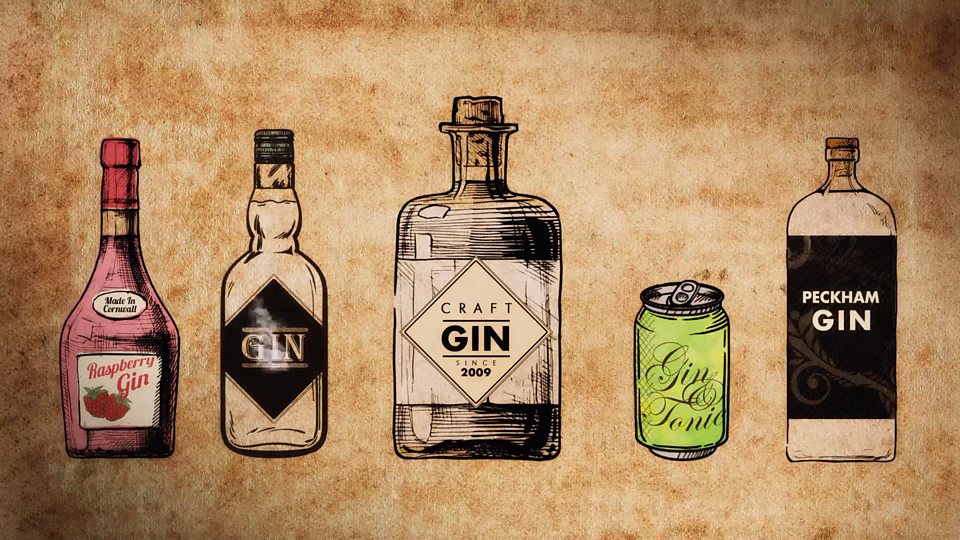
Discover the World of Gin: A Comprehensive Guide to History, Styles, Cocktails and Glossary of Terms
Gin is a spirit that has a rich history, steeped in tradition, and a passionate following. But what exactly is gin and how did it come to be one of the most beloved and versatile spirits in the world?
For those who may be unfamiliar with this classic tipple, gin is a distilled alcoholic beverage made from juniper berries and other botanicals, typically combined with a neutral spirit such as grain alcohol. But, gin's story is so much more than just its ingredients. i
Imagine a time in the 17th century when gin was the drink of choice for the working-class in England. It was cheap, easily accessible, and helped numb the harsh realities of daily life. Fast forward a few hundred years, and gin has shed its rough-and-tumble reputation, transforming into a sophisticated, artisanal spirit, coveted by bartenders and connoisseurs alike.
So, grab a glass and join us as we explore the fascinating history and enduring appeal of gin. From its humble origins to its current status as a global phenomenon, this is a tale that is sure to leave you in a state of gin-inspired bliss.
History of Gin
Gin has a rich and fascinating history that spans several centuries and continents. Its origins can be traced back to the early 17th century in the Netherlands, where it was originally developed as a medicinal spirit made from juniper berries. From there, gin quickly spread throughout Europe, particularly in England where it became popular among the upper classes.
During the late 17th and early 18th centuries, gin underwent a significant evolution, transforming from a medicinal spirit to a popular beverage. This was largely due to the introduction of a new distillation method known as the "London Dry" style, which produced a dry, clean, and crisp gin that was much more palatable than its predecessor. This new style of gin rapidly gained popularity and soon became a staple of British society.
In the centuries that followed, gin continued to evolve and spread to other parts of the world, taking on new forms and flavours along the way. Today, gin is a global spirit that is enjoyed in a variety of cocktails and mixed drinks, from classic gin and tonics to innovative and creative new creations.
The history and evolution of gin provides insight into its unique place in the world of spirits. It is a testament to the ingenuity and creativity of distillers and bartenders, who have continuously pushed the boundaries of what is possible with this versatile and timeless spirit.
- Genever: Also known as "Jenever," this is the precursor to modern gin. It originated in the Low Countries (modern-day Belgium and Netherlands) in the 16th century and was made from distilled malt wine.
- Dutch Courage: Genever was popular among soldiers during the Thirty Years' War as a means of boosting their courage before battle. This gave rise to the term "Dutch Courage."
- Gin Craze: In the late 17th century, gin became incredibly popular in England, leading to a period of excessive consumption known as the "Gin Craze." This resulted in widespread social and economic problems, leading to the passage of the Gin Act of 1751, which aimed to regulate the production and sale of gin.
Types of Gin
Gin is a versatile spirit that comes in a variety of styles and flavours, each with its own unique characteristics. Here's a closer look at some of the most popular types of gin:

- London Dry Gin: This classic style of gin is defined by its strong, juniper-forward flavor and is the most common type of gin used in cocktails. It's made by redistilling a neutral spirit with botanicals, with the majority of the flavor coming from the juniper berries.
- Old Tom Gin: This type of gin, which was popular in the 18th and 19th centuries, is sweeter and milder than London Dry Gin. It's made with a higher proportion of sugar, giving it a softer, more balanced flavor.
- Plymouth Gin: This style of gin, which is made exclusively in Plymouth, England, is a unique and aromatic gin that is slightly sweeter and more floral than London Dry Gin. It's characterised by its soft, smooth texture and crisp, clean finish.
- Navy Strength Gin: Navy Strength Gin is a style of gin that is bottled at a higher proof than other gins, typically around 57% alcohol by volume (ABV). This style of gin got its name from the practice of testing the strength of spirits on naval ships, where the alcohol had to be strong enough to ignite if spilled on gunpowder. Navy Strength gin is known for its bold, powerful flavor and is often used in cocktails that require a stronger gin.
- Bathtub Gin: Bathtub gin refers to a homemade or illicit style of gin that is produced in small, unregulated batches. The name "Bathtub gin" comes from the practice of distilling gin in bathtubs, which were commonly used as makeshift stills during Prohibition in the 1920s. Bathtub gin was originally known for its rough, inconsistent flavor and was often made using low-quality neutral spirits and various botanicals to enhance the flavor. Today, the term "Bathtub gin" is sometimes used to describe a gin with a rough, rustic flavor profile.
- Genever Gin: This is the original style of gin and is made with a base of malt wine, which gives it a rich, malty flavor and a slightly sweet finish. It's popular in the Netherlands and Belgium, and is often served as a digestif.
- New American Gin: This is a newer style of gin that is characterized by its bold, innovative flavor profile. It often incorporates a wider variety of botanicals and spices, resulting in a gin that is more complex and adventurous than traditional styles.
Garnishes and Mixers
Ah, now we're getting to the fun part! In this section, we'll delve into the delicious world of garnishes and mixers that make gin-based cocktails even more enjoyable. Whether you prefer a classic gin and tonic or a creative gin cocktail, you can't go wrong with a few choice garnishes and mixers to add a pop of flavour. So, let's take a closer look at some of the most popular choices
- "Lemon and Lime" Both lemon and lime are citrus fruits that are frequently used as garnishes in gin-based cocktails. They add a tart and tangy flavor to the drink.
- "Cucumber and Mint" Cucumber and mint are both commonly used as garnishes in gin-based cocktails. Cucumber provides a crisp and refreshing flavor, while mint adds a fresh, herbal note.
- "Bitters and Tonic Water" Bitters are a type of alcoholic beverage that are used in small amounts as a flavor enhancer in cocktails. Tonic water is a carbonated water that is usually mixed with gin and is known for its bitter taste. The combination of bitters and tonic water in a gin-based cocktail can add depth and complexity to the drink.
Gin Cocktail Classics
Get ready to sip and savour the timeless gin-filled delights that have been a staple in the world of cocktails for decades! From the iconic martini to the refreshing gin and tonic, we'll be exploring the classic gin cocktails that have stood the test of time.
- Martini: A classic cocktail made with gin and vermouth, garnished with an olive or a lemon twist. It is typically served straight up (without ice) in a chilled martini glass.
- Gin and Tonic: A simple cocktail made with gin, tonic water, and a slice of lemon or lime. The gin and tonic are typically served over ice in a highball glass.
- Negroni: A cocktail made with gin, sweet vermouth, and Campari, garnished with an orange twist. It is usually served on the rocks (over ice) in an Old-Fashioned glass.
- Sloe Gin: A liqueur made from gin infused with sloe berries. It is sweet and has a red or purple color. Sloe gin is typically used as a cocktail ingredient, or served on its own as a digestif.
- Dry Martini: A martini made with a higher ratio of gin to vermouth. It is typically garnished with a lemon twist or an olive.
- Gin Fizz: A cocktail made with gin, lemon juice, simple syrup, and soda water. It is shaken and served over ice in a highball glass.
- Gin Liqueur: A sweetened gin made with the addition of sugar and other flavorings. It is typically served as a dessert or after-dinner drink.
- Gin Sour: A cocktail made with gin, lemon juice, simple syrup, and egg white (optional). It is shaken and served over ice in a chilled Old-Fashioned glass.
Gin Production Process

Get ready to go behind the scenes and explore the magic of gin production! From the careful selection of botanicals to the final blending and bottling, we'll take you through every step of the process that transforms neutral spirit into the delicious gin we all love.
Maceration
- Maceration – Maceration is the process of extracting flavours by crushing or muddling and infusing them with the gin. Gin botanicals are soaked in strong alcohol in the still for a period.
- Botanical – Botanicals are the natural elements such as seeds, roots and berries used in the production of gin to create the drink’s distinctive flavour. This flavour is added to gin by three main means being: maceration, vapour distillation and distillation.
Distillation
-
Base Spirit – A fermented and distilled organic liquor that’s acts as the ‘base’ for gin. Originally gin can be distilled from different grains, grapes and more, acting as the base spirit which later botanicals are added in to.
- Distillation – A process that purifies liquid by vaporising and heating it, then collecting the vapour as it reconditeness into liquid. Producing a distilled gin takes a two-step process – first, a base (neutral spirit) is made and then is flavoured by through re-distillation with botanicals.
- Vapour Distillation – This process takes place when two or more immiscible liquids are heated and the vapour pressure created by this system increases. Due to the vapour pressure the two or more components are combined together.
Blending and Bottling
- Craft gin – Craft gin alludes to the making of real and well-crafted gin. Meaning, often this gin is produced by specialists who are knowledgeable and zealous about creating high quality and gin that is unique to the creator.

Gin Flavour Profiles
- Dry gin – Refers to there being no added (artificial) flavouring. Meaning that the flavours are all natural from the botanicals.
- Flavoured gin – A flavoured gin is a gin that is dominated by a single flavour and usually takes on the colour of the main ingredient flavouring it.
Gin Tasting Terminology
Gin is a complex spirit that offers a unique experience with every sip. A crucial aspect of understanding and appreciating gin is learning the terminology used to describe its various qualities. From the initial aroma, or "nose," to the taste, or "palate," and the aftertaste, or "finish," each aspect contributes to the overall experience of the gin. In this section, we will explore the key terms used in gin tasting to help you better understand and enjoy the different qualities of this versatile spirit.
- Nose - The aroma or scent of a gin is referred to as its "nose." It is the initial impression that is formed when a gin is smelled and can greatly impact the overall perception of the gin. A gin's nose can be influenced by its ingredients and the process used to make it, such as the type of botanicals used and whether they are macerated or distilled. The nose of a gin can be floral, herbal, spicy, citrusy, or any combination of these.
- Palate - The taste of a gin is referred to as its "palate." The palate is what you experience when you take a sip of the gin, and is often a continuation of the aroma or nose of the gin. It is a combination of the gin's flavour and mouthfeel, and can be influenced by the type of base spirit used, the botanicals used, and the distillation process. The palate can be sweet, sour, bitter, or any combination of these, and can range from light and crisp to bold and full-bodied.
- Finish - The "finish" of a gin refers to the aftertaste or sensation that remains in the mouth after swallowing the gin. It can be long or short, and can be affected by the gin's alcohol content, botanicals, and mouthfeel. A gin with a long finish may leave a pleasant or lingering taste in the mouth, while a gin with a short finish may not. The finish can range from smooth and clean to spicy or warming, and can greatly impact the overall enjoyment of a gin.
Try a gin tasting kit to discover which gin style suits your taste.
Key Ingredients in Gin

Gin is made by infusing a neutral spirit with a blend of botanicals, which are the natural ingredients that give gin its flavour and aroma. Some of the most commonly used botanicals in gin include juniper berries, coriander, angelica root, and citrus peel.
- Juniper Berries - Juniper berries are a key ingredient in the production of gin and are one of the defining characteristics of the spirit. To be legally considered gin, the spirit must contain juniper as the predominant flavour. Juniper berries come from the juniper shrub, an evergreen plant that is native to the Northern Hemisphere. The berries grow on the plant as cones, which resemble berries, and are known for their distinct, pine-like aroma and flavour.
- Coriander - Coriander is a spice that is widely used in gin production to add a fresh, slightly citrusy flavour. It is often used in conjunction with other botanicals such as angelica root and citrus peel to balance the juniper flavour and create a well-rounded gin.
- Angelica Root - Angelica root is a botanical that is widely used in gin production due to its earthy, slightly spicy flavour. It is often used to add depth and complexity to the flavour profile of gin and is believed to help balance out the sweetness of the botanicals and the sharpness of the juniper berries.
Sipping on Gin: Benefits of Moderate Consumption
Gin has been enjoyed for centuries and is now one of the most popular spirits in the world. While excessive alcohol consumption can have negative health effects, drinking gin in moderation can offer several benefits.

For starters, gin contains antioxidants, which help to protect the body against damage from free radicals. Drinking gin in moderation can also aid digestion, due to the presence of botanicals like juniper, coriander, and angelica root. These botanicals are believed to have anti-inflammatory properties and help to soothe an upset stomach.
Additionally, gin is a low-calorie spirit, making it a healthier option compared to other alcoholic beverages. One serving of gin (30ml) contains only 97 calories, which is significantly less than a serving of wine or beer.
It's important to note that the benefits of drinking gin in moderation should not be used as a reason to overindulge. It's still essential to practice responsible drinking and maintain a balanced diet and lifestyle.
By incorporating gin into a balanced lifestyle, it can provide not only a refreshing taste but also potential health benefits. Whether you prefer a classic gin and tonic or a creative cocktail, savour every sip and enjoy the benefits of moderate gin consumption.
How to expand your Gin knowledge
Expanding your gin knowledge can be a fun and exciting journey. Here are some tips to help you deepen your understanding of gin and its various facets:
- Visit a gin distillery: Visiting a gin distillery is a great way to learn about the history and process of gin production. You can see the distillation process first-hand, learn about the ingredients that go into different gins, and taste different varieties to compare and contrast the flavours.
- Attend a gin tasting event: Gin tasting events are a great way to sample a variety of gins and learn about the different flavour profiles and ingredients. You can also talk to experts in the industry and hear their perspectives on the world of gin.
- Try a new gin cocktail recipe: Experimenting with different gin cocktails is a fun way to expand your knowledge and appreciation for gin. Try creating a classic gin cocktail like a martini or gin and tonic, or explore new recipes that incorporate unique ingredients and flavours.
- Subscribe to Gin Loot: Gin Loot is a monthly subscription service that delivers a curated selection of gins to your doorstep. This is a great way to discover new gins and try them in the comfort of your own home. You can also keep up-to-date with the latest gin trends and learn about different gins and their history.
In conclusion, the world of gin is truly a fascinating one, with a rich history and diverse range of styles and flavours. From London Dry to Navy Strength, Old Tom to Bathtub, there's a gin for everyone's taste buds. And, with the perfect mix of garnishes and mixers, you can create a gin-based cocktail that's truly unique and delicious. Whether you're a seasoned gin connoisseur or just starting to explore this versatile spirit, this Ultimate Gin Glossary of Terms is the perfect place to brush up on your knowledge. So, what are you waiting for? Now that you speak the language, buy gin online and explore these styles yourself.
Join Gin Loot's monthly gin tasting subscription to learn more about gin and elevate your sipping game to the next level! Subscribe now and be a part of the gin-tastic community!













